Threatened Raptor Species Distribution in Nigeria: Influence of Socio-Cultural Factors and Human–Wildlife Conflicts
Abstract
1. Introduction
2. Materials and Methods
2.1. Study Area Description
2.2. Data Sources
2.2.1. Raptor Occurrence Data
2.2.2. Remote Sensing, Anthropogenic Layers, and Protected Areas
2.2.3. Survey Data: Socio-cultural Questionnaires
2.3. Model Fitting and Performance
Hotspot Analysis of Threatened Raptors
2.4. Statistical Analysis
2.4.1. Anthropogenic Pressures and Protected Areas
2.4.2. Socio-cultural Data Analysis
3. Results
3.1. Distribution of Threatened Raptors
3.2. Impact of Anthropogenic Variables
3.3. Description of the Respondents
3.3.1. Sentiment Analysis: Perceptions and Attitudes Towards Raptors
3.3.2. Latent Class Analysis: Perception Classes
3.3.3. Relationship Between Knowledge, Perceptions, and Raptor Abundance
3.3.4. Influence of Perceptions, Cluster, and Pentad on Attitudes
4. Discussion
4.1. Influence of Population Density and Spatial Gaps
4.2. Influence of Human Perceptions on Raptor Conservation
4.3. Cultural or Historical Factors Influencing Attitudes
4.4. Recommendations for Policy and Conservation
5. Conclusions
Supplementary Materials
Author Contributions
Funding
Informed Consent Statement
Data Availability Statement
Acknowledgments
Conflicts of Interest
References
- McClure, C.J.; Westrip, J.R.; Johnson, J.A.; Schulwitz, S.E.; Virani, M.Z.; Davies, R.; Symes, A.; Wheatley, H.; Thorstrom, R.; Amar, A.; et al. State of the world’s raptors: Distributions, threats, and conservation recommendations. Biol. Conserv. 2018, 227, 390–402. [Google Scholar] [CrossRef]
- Smits, J.E.; Fernie, K.J. Avian wildlife as sentinels of ecosystem health. Comp. Immunol. Microbiol. Infect. Dis. 2013, 36, 333–342. [Google Scholar] [CrossRef]
- Babura Sabo, B.; Mohammed, S.; Zakariya Karkama, M. Raptors In Baturiya Birds Sanctuary Northwestern, Nigeria. J. Agric. Econ. Environ. Soc. Sci. 2022, 8, 34–37. [Google Scholar] [CrossRef]
- Fowler, D.W.; Freedman, E.A.; Scannella, J.B. Predatory functional morphology in raptors: Interdigital variation in talon size is related to prey restraint and immobilisation technique. PLoS ONE 2009, 4, e7999. [Google Scholar] [CrossRef]
- Potier, S. Visual adaptations in predatory and scavenging diurnal raptors. Diversity 2020, 12, 400. [Google Scholar] [CrossRef]
- Sabo, B.B.; Mohammed, S.; Danladi, S.I. Assessment of raptor species relative abundance in Hadejia Nguru Wetlands, Nigeria. Gadau J. Pure Allied Sci. 2022, 1, 189–199. [Google Scholar] [CrossRef]
- Shaw, P.; Ogada, D.; Dunn, L.; Buij, R.; Amar, A.; Garbett, R.; Herremans, M.; Virani, M.Z.; Kendall, C.J.; Croes, B.M.; et al. African savanna raptors show evidence of widespread population collapse and a growing dependence on protected areas. Nat. Ecol. Evol. 2024, 8, 45–56. [Google Scholar] [CrossRef]
- Barbar, F.; Werenkraut, V.; Morales, J.M.; Lambertucci, S.A. Emerging ecosystems change the spatial distribution of top carnivores even in poorly populated areas. PLoS ONE 2015, 10, e0118851. [Google Scholar] [CrossRef]
- Buij, R.; Croes, B.M. Raptor habitat use in the Lake Chad Basin: Insights into the effect of flood-plain transformation on Afrotropical and Palearctic raptors. Bird Conserv. Int. 2013, 23, 199–213. [Google Scholar] [CrossRef]
- Buij, R.; Croes, B.M.; Komdeur, J. Biogeographical and anthropogenic determinants of landscape-scale patterns of raptors in West African savannas. Biodivers. Conserv. 2013, 22, 1623–1646. [Google Scholar] [CrossRef]
- Ngila, P.M.; Chiawo, D.O.; Owuor, M.A.; Wasonga, V.O.; Mugo, J.W. Mapping suitable habitats for globally endangered raptors in Kenya: Integrating climate factors and conservation planning. Ecol. Evol. 2023, 13, e10443. [Google Scholar] [CrossRef]
- Atuo, F.A.; O’Connell, T.J.; Abanyam, P.U. An assessment of socio-economic drivers of avian body parts trade in West African rainforests. Biol. Conserv. 2015, 191, 614–622. [Google Scholar] [CrossRef]
- Bennett, N.J. Using perceptions as evidence to improve conservation and environmental management. Conserv. Biol. 2016, 30, 582–592. [Google Scholar] [CrossRef] [PubMed]
- Ingold, T. The Perception of the Environment: Essays on Livelihood, Dwelling and Skill; Routledge: Abingdon, UK, 2021. [Google Scholar] [CrossRef]
- Montenegro-Pazmiño, E.; Muñoz, G. Unveiling Social Dynamics in People’s Perception of Raptors to Guide Effective Conservation Strategies. J. Ethnobiol. 2024, 44, 112–128. [Google Scholar] [CrossRef]
- Buij, R.; Nikolaus, G.; Whytock, R.; Ingram, D.J.; Ogada, D. Trade of threatened vultures and other raptors for fetish and bushmeat in West and Central Africa. Oryx 2016, 50, 606–616. [Google Scholar] [CrossRef]
- BirdLife International. Country Profile: Nigeria. 2024. Available online: https://datazone.birdlife.org/country/nigeria (accessed on 30 January 2025).
- Onoja, J.D.; Tende, T.; Omotoriogun, T.C.; Ottosson, U.; Manu, S.A.; Mwansat, G.S. Raptors in Yankari Game Reserve and surrounding unprotected area, Nigeria. Malimbus 2014, 36, 67–75. [Google Scholar]
- Ogunsote, O.O.; Prucnal-Ogunsote, B. Defining climatic zones for architectural design in Nigeria: A systematic delineation. J. Environ. Technol. 2002, 1, 1–14. [Google Scholar]
- Osinowo, A.A.; Okogbue, E.C. Investigation of the sky optical conditions over selected stations in the major vegetation zones of Nigeria. Int. J. Sustain. Energy 2014, 33, 357–366. [Google Scholar] [CrossRef]
- Fasona, M.; Omojola, A.; Onyeahialam, A. Mapping land degradation and forest resource loss from fused landsat tm and nigeriasat-1 images in some parts of the southwest coast of Nigeria. IAHS Publ. 2007, 316, 110. [Google Scholar] [CrossRef]
- Liman, H.M.; Obaje, N.G.; Sidi, A.A.; Nwaerema, P. Impact evaluation of artisanal and small-scale mining on land use land cover: Implication for sustainable mining environment in Niger State, Nigeria. J. Earth Sci. Geotech. Eng. 2021, 11, 33–45. [Google Scholar] [CrossRef] [PubMed]
- Merem, E.C.; Twumasi, Y.; Wesley, J.; Isokpehi, P.; Shenge, M.; Fageir, S.; Crisler, M.; Romorno, C.; Hines, A.; Hirse, G.; et al. Assessing the ecological effects of mining in West Africa: The case of Nigeria. Int. J. Min. Eng. Miner. Process. 2017, 6, 1–19. [Google Scholar] [CrossRef]
- Ekoh, P.C.; George, E.; Ejimkaraonye, C. Nigeria demographic report: The effect of overpopulation on life expectancy. Etude Popul. Afr. 2020, 34, 5106–5114. [Google Scholar]
- Pontianus, V.J.; Oruonye, E.D. The Nigerian population: A treasure for national development or an unsurmountable national challenge. Int. J. Sci. Res. Arch. 2021, 2, 136–142. [Google Scholar] [CrossRef]
- Tende, T.; Iniunam, I.A.; Ivande, S.T.; Awoyemi, A.G.; Danmallam, B.A.; Ringim, A.S.; Bako, L.A.; Ramzy, F.J.; Kazeh, N.W.; Izang, A.I.; et al. Citizen science mitigates the lack of distributional data on Nigerian birds. Ecol. Evol. 2024, 14, e11280. [Google Scholar] [CrossRef]
- Rosas, Y.M.; Peri, P.L.; Pidgeon, A.M.; Politi, N.; Pedrana, J.; Díaz-Delgado, R.; Pastur, G.M. Human footprint defining conservation strategies in Patagonian landscapes: Where we are and where we want to go? J. Nat. Conserv. 2021, 59, 125946. [Google Scholar] [CrossRef]
- Salafsky, N.; Relton, C.; Young, B.E.; Lamarre, P.; Böhm, M.; Chénier, M.; Cochrane, E.; Dionne, M.; He, K.K.; Suresh, V.; et al. Classification of direct threats to the conservation of ecosystems and species 4.0. Conserv. Biol. 2025, 39, e14434. [Google Scholar] [CrossRef]
- Venter, O.; Sanderson, E.W.; Magrach, A.; Allan, J.R.; Beher, J.; Jones, K.R.; Possingham, H.P.; Laurance, W.F.; Wood, P.; Fekete, B.M.; et al. Global terrestrial Human Footprint maps for 1993 and 2009. Sci. Data 2016, 3, 160067. [Google Scholar] [CrossRef] [PubMed]
- Kennedy, C.M.; Oakleaf, J.R.; Theobald, D.M.; Baruch-Mordo, S.; Kiesecker, J. Managing the middle: A shift in conservation priorities based on the global human modification gradient. Glob. Change Biol. 2019, 25, 811–826. [Google Scholar] [CrossRef]
- Carrete, M.; Tella, J.L. Individual consistency in flight initiation distances in burrowing owls: A new hypothesis on disturbance-induced habitat selection. Biol. Lett. 2010, 6, 167–170. [Google Scholar] [CrossRef] [PubMed]
- Thiollay, J.M. Severe decline of large birds in the northern Sahel of West Africa: A long-term assessment. Bird Conserv. Int. 2006, 16, 353–365. [Google Scholar] [CrossRef]
- O’Bryan, C.J.; Allan, J.R.; Suarez-Castro, A.F.; Delsen, D.M.; Buij, R.; McClure, C.J.; Rehbein, J.A.; Virani, M.Z.; McCabe, J.D.; Tyrrell, P.; et al. Human impacts on the world’s raptors. Front. Ecol. Evol. 2022, 10, 624896. [Google Scholar] [CrossRef]
- Rodríguez-Estrella, R.; Donázar, J.A.; Hiraldo, F. Raptors as indicators of environmental change in the scrub habitat of Baja California Sur, Mexico. Conserv. Biol. 1998, 12, 921–925. [Google Scholar] [CrossRef]
- UNEP-WCMC. Protected Area Profile for Nigeria from the World Database on Protected Areas, February 2025. Available online: www.protectedplanet.net (accessed on 20 January 2025).
- Friant, S.; Paige, S.B.; Goldberg, T.L. Drivers of bushmeat hunting and perceptions of zoonoses in Nigerian hunting communities. PLoS Neglected Trop. Dis. 2015, 9, e0003792. [Google Scholar] [CrossRef]
- Awoyemi, A.G.; Ibáñez-Rueda, N.; Guardiola, J.; Ibáñez-Álamo, J.D. Human-nature interactions in the Afrotropics: Experiential and cognitive connections among urban residents in southern Nigeria. Ecol. Econ. 2024, 218, 108105. [Google Scholar] [CrossRef]
- Fa, J.E.; Seymour, S.; Dupain, J.E.F.; Amin, R.; Albrechtsen, L.; Macdonald, D. Getting to grips with the magnitude of exploitation: Bushmeat in the Cross–Sanaga rivers region, Nigeria and Cameroon. Biol. Conserv. 2006, 129, 497–510. [Google Scholar] [CrossRef]
- Amusa, T.O.; Azeez, K.K.; Olabode, E.A. Use of Geotracker and Kobocollect in monitoring patrol effort and illegal activities in Omo Forest reserve, Nigeria. PARKS 2021, 27, 37. [Google Scholar] [CrossRef]
- Lee, A.T.K.; Ottosson, U.; Jackson, C.; Shema, S.; Reynolds, C. Urban areas have lower species richness, but maintain functional diversity: Insights from the African Bird Atlas Project. Ostrich 2021, 92, 1–15. [Google Scholar] [CrossRef]
- MacKenzie, D.I.; Nichols, J.D.; Lachman, G.B.; Droege, S.; Andrew Royle, J.; Langtimm, C.A. Estimating site occupancy rates when detection probabilities are less than one. Ecology 2002, 83, 2248–2255. [Google Scholar] [CrossRef]
- Sauer, J.R.; Peterjohn, B.G.; Link, W.A. Observer differences in the North American breeding bird survey. Auk 1994, 111, 50–62. [Google Scholar] [CrossRef]
- Cleasby, I.R.; Owen, E.; Wilson, L.; Wakefield, E.D.; O’Connell, P.; Bolton, M. Identifying important at-sea areas for seabirds using species distribution models and hotspot mapping. Biol. Conserv. 2020, 241, 108375. [Google Scholar] [CrossRef]
- Getis, A.; Ord, J.K. The analysis of spatial association by use of distance statistics. Geogr. Anal. 1992, 24, 189–206. [Google Scholar] [CrossRef]
- Kwan, M.P. The uncertain geographic context problem. Ann. Assoc. Am. Geogr. 2012, 102, 958–968. [Google Scholar] [CrossRef]
- R Core Team. A Language and Environment for Statistical Computing; R Foundation for Statistical Computing: Vienna, Austria, 2024. Available online: https://www.R-project.org/ (accessed on 20 January 2025).
- Zuur, A.F.; Ieno, E.N.; Walker, N.J.; Saveliev, A.A.; Smith, G.M. Mixed Effects Models and Extensions in Ecology with R; Springer: New York, NY, USA, 2009; Volume 574, p. 574. [Google Scholar] [CrossRef]
- Kelling, S.; Johnston, A.; Bonn, A.; Fink, D.; Ruiz-Gutierrez, V.; Bonney, R.; Fernandez, M.; Hochachka, W.M.; Julliard, R.; Kraemer, R.; et al. Using semistructured surveys to improve citizen science data for monitoring biodiversity. BioScience 2019, 69, 170–179. [Google Scholar] [CrossRef] [PubMed]
- DeFries, R.; Hansen, A.; Turner, B.L.; Reid, R.; Liu, J. Land use change around protected areas: Management to balance human needs and ecological function. Ecol. Appl. 2007, 17, 1031–1038. [Google Scholar] [CrossRef] [PubMed]
- Geldmann, J.; Barnes, M.; Coad, L.; Craigie, I.D.; Hockings, M.; Burgess, N.D. Effectiveness of terrestrial protected areas in reducing habitat loss and population declines. Biol. Conserv. 2013, 161, 230–238. [Google Scholar] [CrossRef]
- Oxford University Press. Oxford English Dictionary; Oxford University Press: Oxford, UK, 2025. Available online: https://www.oed.com/ (accessed on 28 February 2025).
- Jayanthi, M.A.; Shanthi, E. Quest_SA: Preprocessing Method for Closed-Ended Questionnaires Using Sentiment Analysis through Polarity. Mob. Inf. Syst. 2022, 2022, 4733550. [Google Scholar] [CrossRef]
- Tejwani, R. Sentiment analysis: A survey. arXiv 2014, arXiv:1405.2584. [Google Scholar]
- Scheier, L.M.; Komarc, M. Are e-cigarette users a unique group of smokers? latent class analysis of the National youth tobacco survey. J. Drug Educ. 2020, 49, 87–114. [Google Scholar] [CrossRef]
- Walsh, K.; Mehta, A.H.; Buehler, Z.; Wall, M.; Santelli, J.; Hirsch, J.S.; Mellins, C.A. The socio-ecological context of US college student drinking: A latent class analysis. Addict. Behav. 2023, 141, 107666. [Google Scholar] [CrossRef]
- Ogada, D.; Shaw, P.; Beyers, R.L.; Buij, R.; Murn, C.; Thiollay, J.M.; Beale, C.M.; Holdo, R.M.; Pomeroy, D.; Sinclair, A.R.; et al. Another continental vulture crisis: Africa’s vultures collapsing toward extinction. Conserv. Lett. 2016, 9, 89–97. [Google Scholar] [CrossRef]
- Sabo, B.B.; Salisu, M. Assessment of Species Diversity and Relative Abundance of Raptors in North Western Region of Nigeria. Direct Res. J. Agric. Food Sci. 2023, 11, 18. [Google Scholar]
- Leyhe, J.E.; Ritchison, G. Perch sites and hunting behavior of Red-tailed Hawks (Buteo jamaicensis). J. Raptor Res. 2004, 38, 3. [Google Scholar]
- Thiollay, J.M.; Clobert, J. Comparative foraging adaptations of small raptors in a dense African savanna. Ibis 1990, 132, 42–57. [Google Scholar] [CrossRef]
- Amar, A.; Buij, R.; Suri, J.; Sumasgutner, P.; Virani, M.Z. Conservation and ecology of African raptors. In Birds of Prey: Biology and Conservation in the XXI Century; Springer International Publishing: Cham, Switzerland, 2018; pp. 419–455. [Google Scholar] [CrossRef]
- Herremans, M.; Herremans-Tonnoeyr, D. Land use and the conservation status of raptors in Botswana. Biol. Conserv. 2000, 94, 31–41. [Google Scholar] [CrossRef]
- Wittemyer, G.; Elsen, P.; Bean, W.T.; Burton, A.C.O.; Brashares, J.S. Accelerated human population growth at protected area edges. Science 2008, 321, 123–126. [Google Scholar] [CrossRef]
- Buechley, E.R.; Oppel, S.; Beatty, W.S.; Nikolov, S.C.; Dobrev, V.; Arkumarev, V.; Saravia, V.; Bougain, C.; Bounas, A.; Kret, E.; et al. Identifying critical migratory bottlenecks and high-use areas for an endangered soaring bird across three continents. J. Avian Biol. 2019, 49, e01629. [Google Scholar] [CrossRef]
- Wich, S.A.; Garcia-Ulloa, J.; Kühl, H.S.; Humle, T.; Lee, J.S.; Koh, L.P. Will oil palm’s homecoming spell doom for Africa’s great apes? Curr. Biol. 2014, 24, 1659–1663. [Google Scholar] [CrossRef]
- Amar, A.; Cloete, D. Quantifying the decline of the Martial Eagle Polemaetus bellicosus in South Africa. Bird Conserv. Int. 2018, 28, 363–374. [Google Scholar] [CrossRef]
- Brown, C.J. Declining Martial Polemaetus bellicosus and Tawny Aquila rapax Eagle populations and causes of mortality on farmlands in central Namibia. Biol. Conserv. 1991, 56, 49–62. [Google Scholar] [CrossRef]
- Tilman, D.; May, R.M.; Lehman, C.L.; Nowak, M.A. Habitat destruction and the extinction debt. Nature 1994, 371, 65–66. [Google Scholar] [CrossRef]
- Coetzee, B.W.; Gaston, K.J.; Chown, S.L. Local scale comparisons of biodiversity as a test for global protected area ecological performance: A meta-analysis. PLoS ONE 2014, 9, e105824. [Google Scholar] [CrossRef]
- Nyirenda, V.R.; Musonda, F.; Kambole, S.; Tembo, S. Peasant farmer–raptor conflicts around Chembe Bird Sanctuary, Zambia, Central Africa poultry predation, ethnobiology, land use practices and conservation. Anim. Biodivers. Conserv. 2017, 40, 121–132. [Google Scholar] [CrossRef]
- Ballejo, F.; Grilli, M.G.; Lambertucci, S.A. A long and troublesome journey: People’s perceptions and attitudes along the migratory path of a scavenger bird. Ethnobiol. Conserv. 2019, 8, 13. [Google Scholar] [CrossRef]
- Ogada, D.L.; Torchin, M.E.; Kinnaird, M.F.; Ezenwa, V.O. Effects of vulture declines on facultative scavengers and potential implications for mammalian disease transmission. Conserv. Biol. 2012, 26, 453–460. [Google Scholar] [CrossRef]
- Manqele, N.S.; Selier, S.J.; Taylor, J.; Downs, C.T. Vulture perceptions in a socio-ecological system: A case study of three protected areas in KwaZulu-Natal, South Africa. J. Ornithol. 2023, 164, 789–801. [Google Scholar] [CrossRef]
- Whytock, R.C.; Buij, R.; Virani, M.Z.; Morgan, B.J. Do large birds experience previously undetected levels of hunting pressure in the forests of Central and West Africa. Oryx 2016, 50, 76–83. [Google Scholar] [CrossRef]
- Karlsson, C.; Williams, M.M.; Ibrahim, J.; Tende, T.; Ottosson, U. Free-ranging poultry owners’ opinion towards raptors in Plateau State, Nigeria. Ostrich 2025, 96, 74–79. [Google Scholar] [CrossRef]
- Tiwari, G.; Pandey, P.; Kaul, R.; Singh, R. Farmers’ perception of the ecosystem services provided by diurnal raptors in arid Rajasthan. PeerJ 2023, 11, e15996. [Google Scholar] [CrossRef] [PubMed]
- Williams, M.M.; Yilgwan, P.L.; Junior, M.F.; Adendem, M.N.; Pam, E.D.; Yiljika, J.D. Roadside Reflection of Nigeria’s Declining Vultures: A study across Five Contiguous States (Plateau, Kaduna, Nasarawa, Benue, and Enugu). Eur. J. Ecol. Biol. Agric. 2024, 1, 15–22. [Google Scholar] [CrossRef] [PubMed]
- Ukpoju, E.A.; Abatan, A.; Obaedo, B.O.; Balogun, O.D.; Adegbite, A. Assessing the effectiveness of biodiversity conservation strategies in Nigeria: A comprehensive review. Int. J. Appl. Res. Soc. Sci. 2023, 5, 577–598. [Google Scholar] [CrossRef]
- Beresford, A.E.; Buchanan, G.M.; Donald, P.F.; Butchart, S.H.M.; Fishpool, L.D.C.; Rondinini, C. Poor overlap between the distribution of protected areas and globally threatened birds in Africa. Anim. Conserv. 2011, 14, 99–107. [Google Scholar] [CrossRef]
- Newing, H.; Brittain, S.; Buchadas, A.; del Giorgio, O.; Grasham, C.F.; Ferritto, R.; Marquez, J.R.G.; Khanyari, M.; König, B.; Kulkarni, A.; et al. ‘Participatory’ conservation research involving indigenous peoples and local communities: Fourteen principles for good practice. Biol. Conserv. 2024, 296, 110708. [Google Scholar] [CrossRef]
- Alba-Quilo, J.; González-Zambrano, R. Percepciones biológicas y culturales en la conservación de las aves rapaces centrada en la UEF Domingo Faustino Sarmiento, Quito-Ecuador. Rev. Cienc. Agropecu. ALLPA 2022, 5, 14–25. [Google Scholar] [CrossRef]
- Cailly Arnulphi, V.B.; Lambertucci, S.A.; Borghi, C.E. Education can improve the negative perception of a threatened long-lived scavenging bird, the Andean condor. PLoS ONE 2017, 12, e0185278. [Google Scholar] [CrossRef] [PubMed]
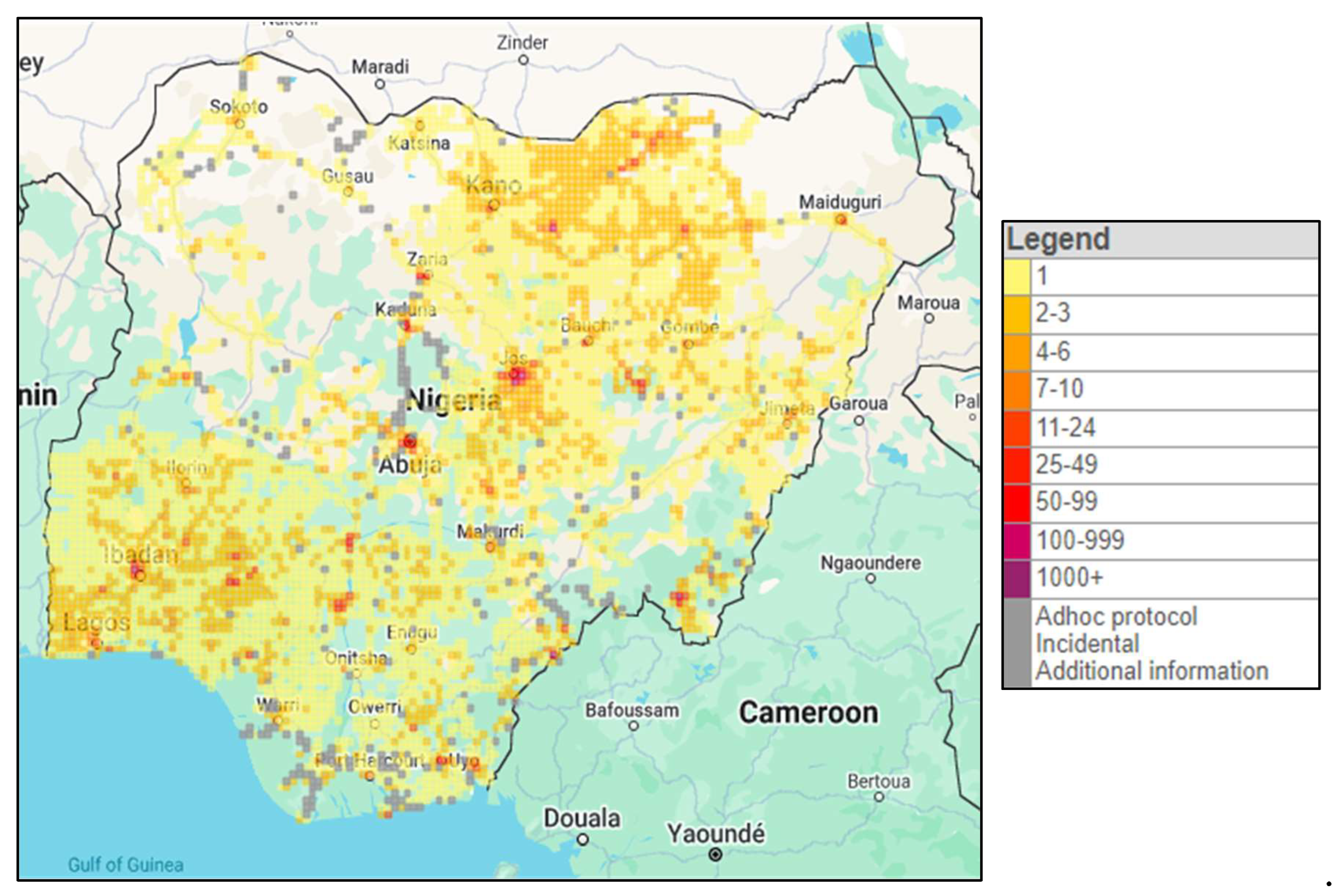
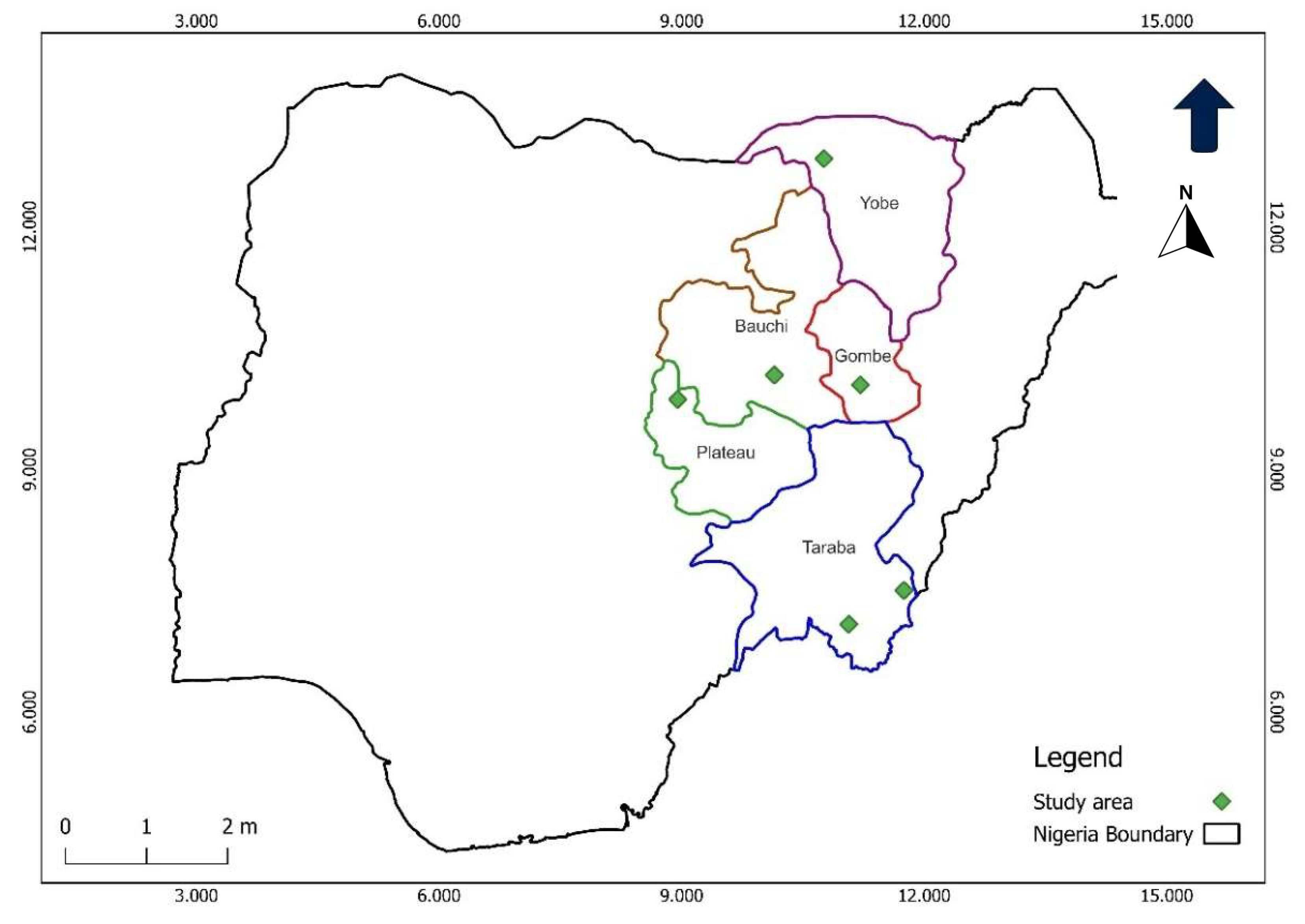
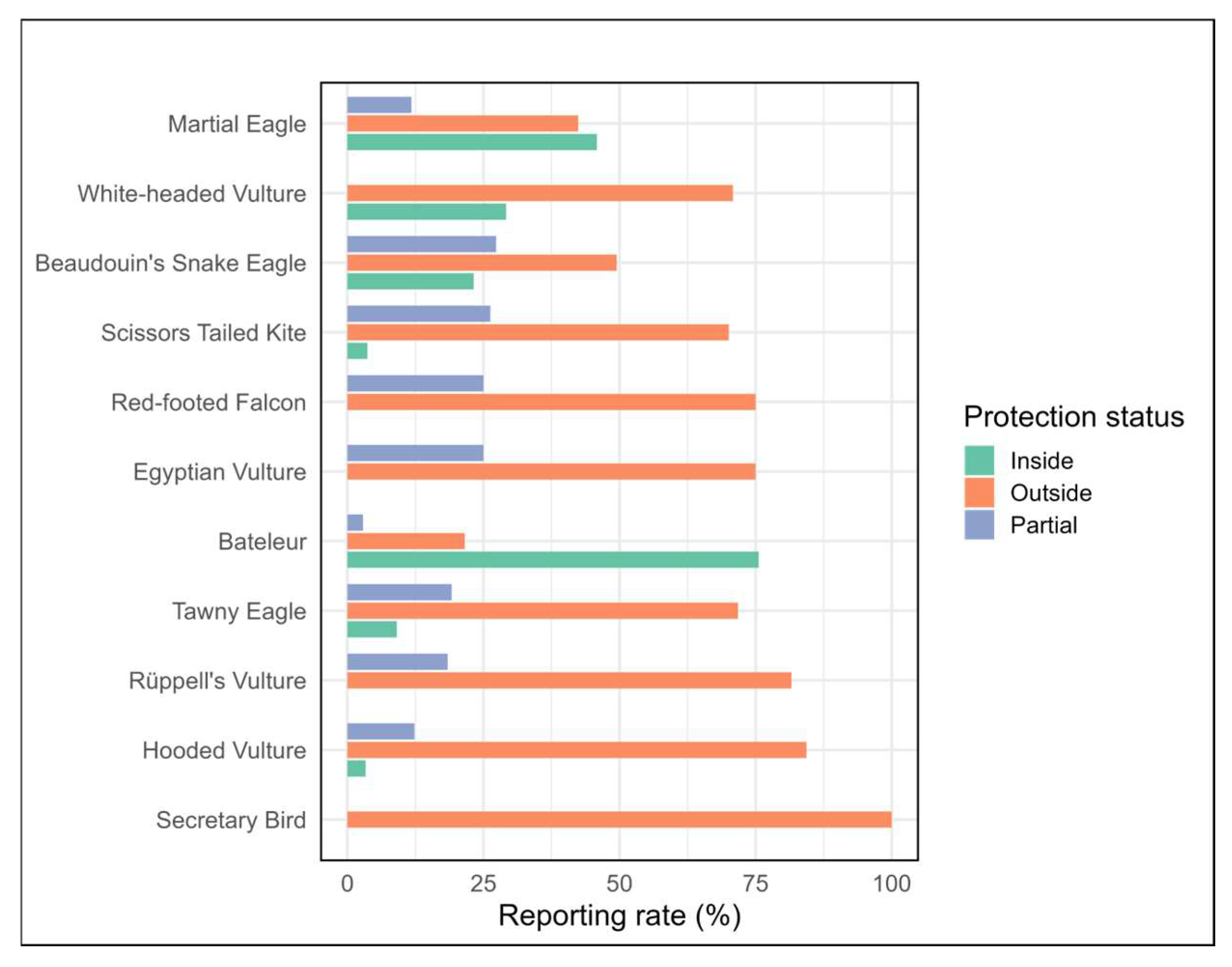
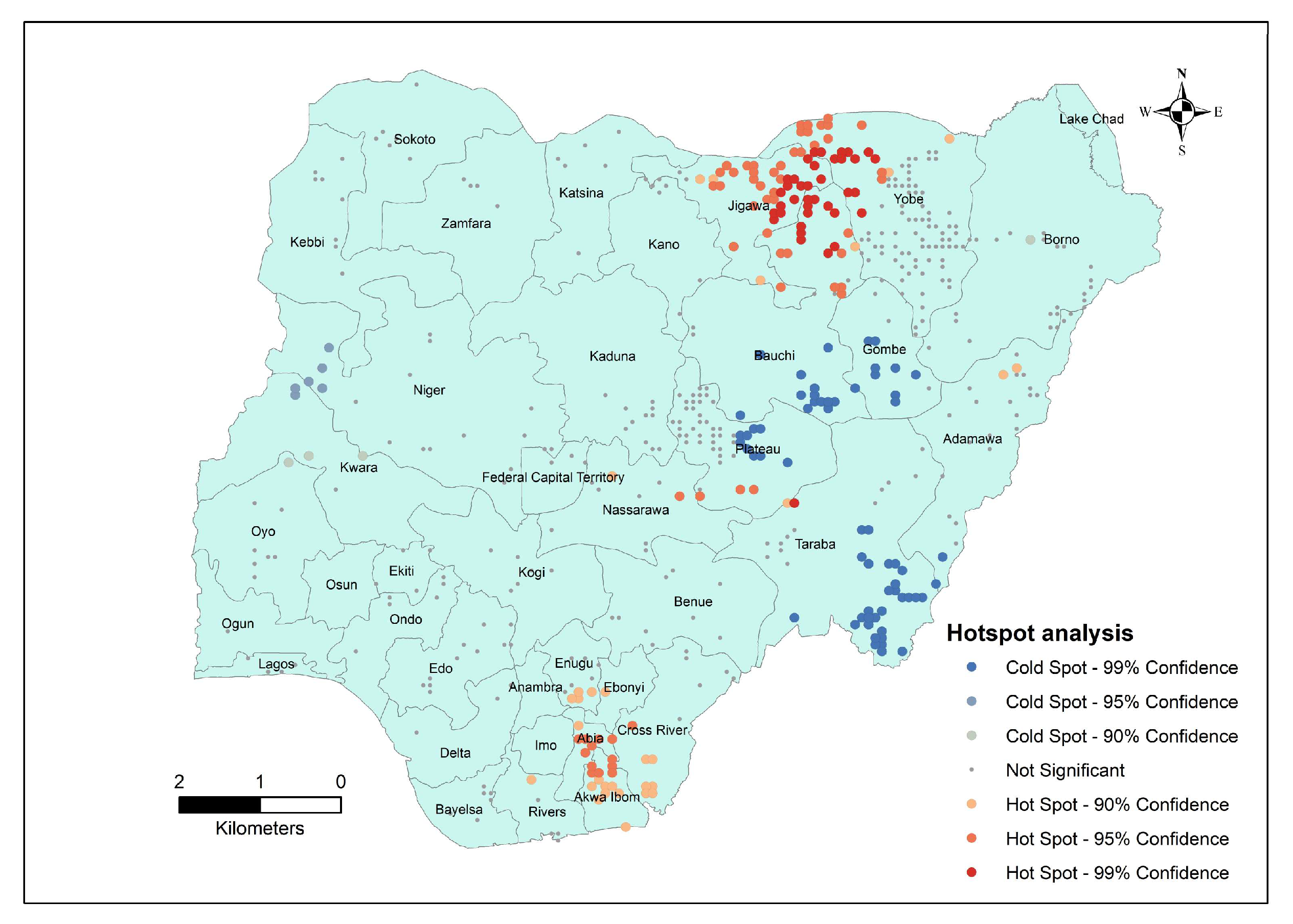
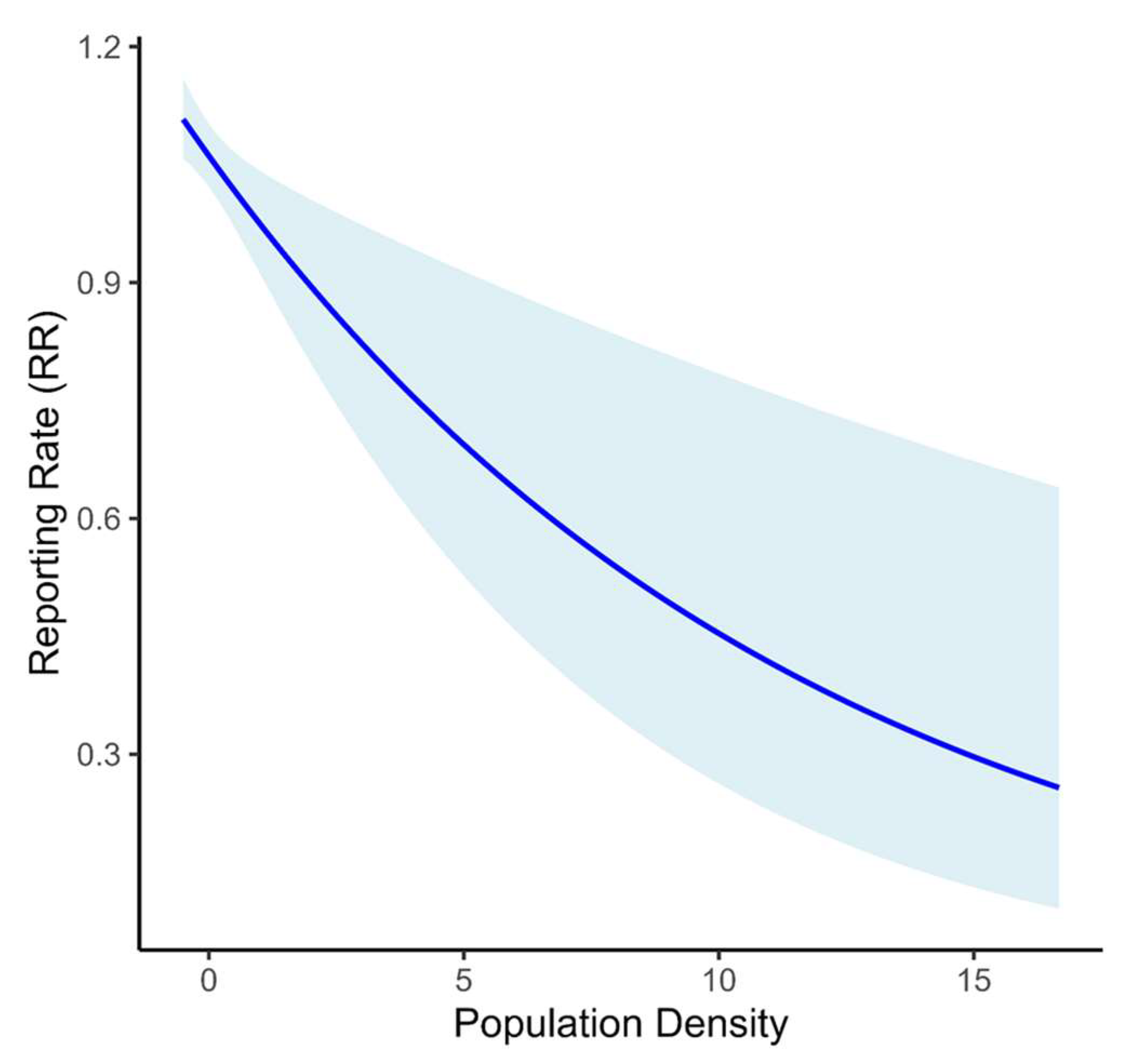
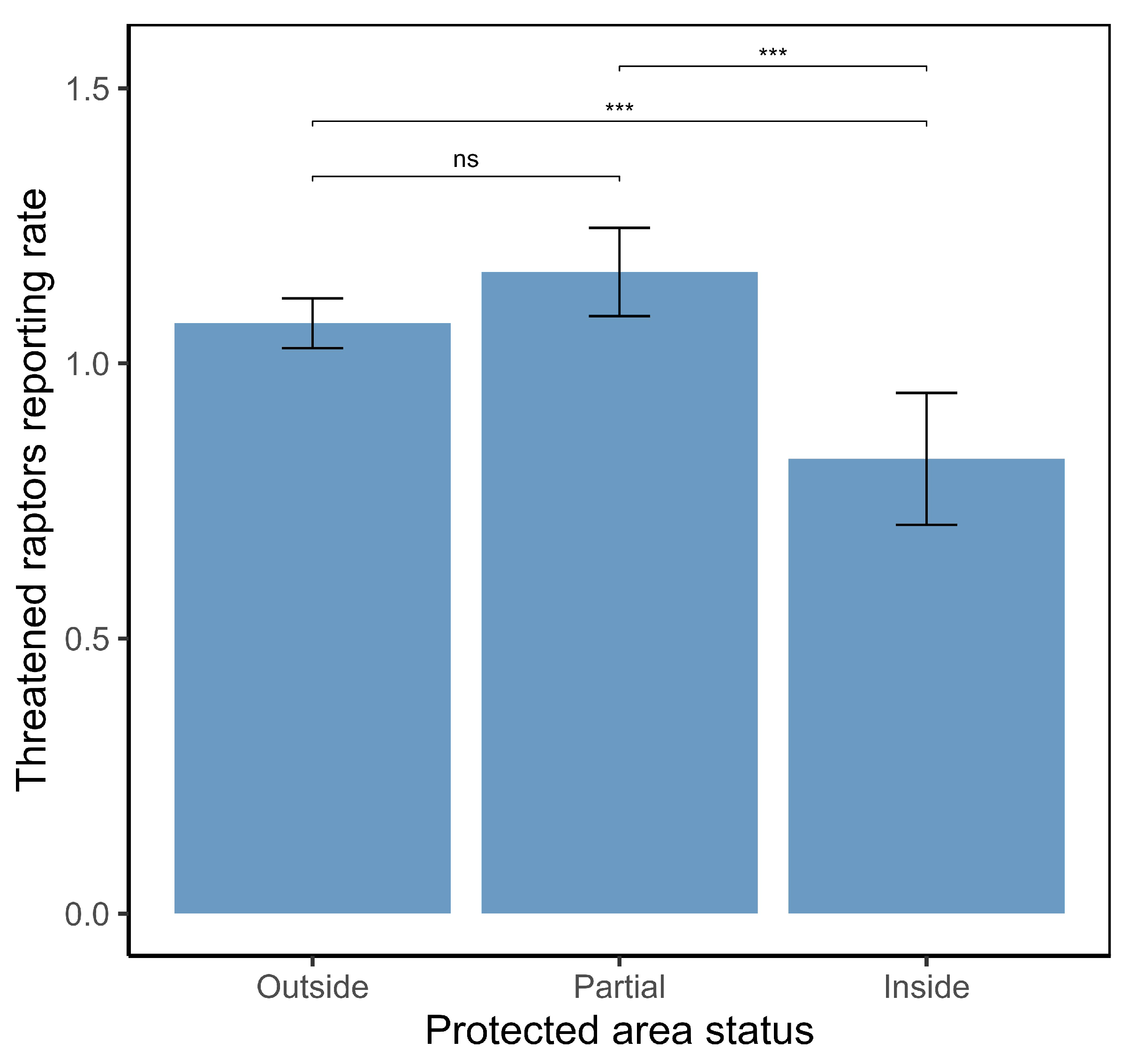

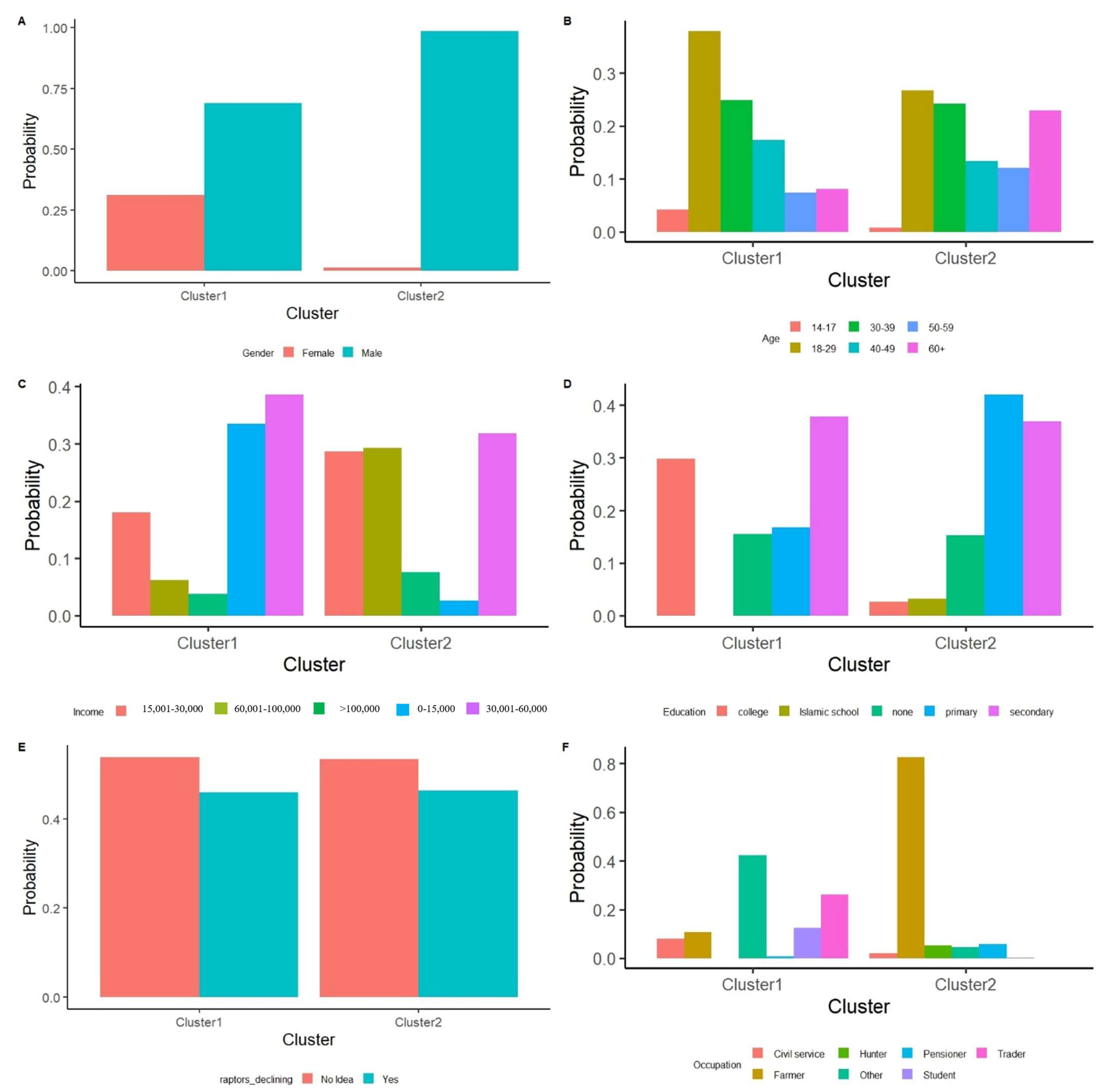
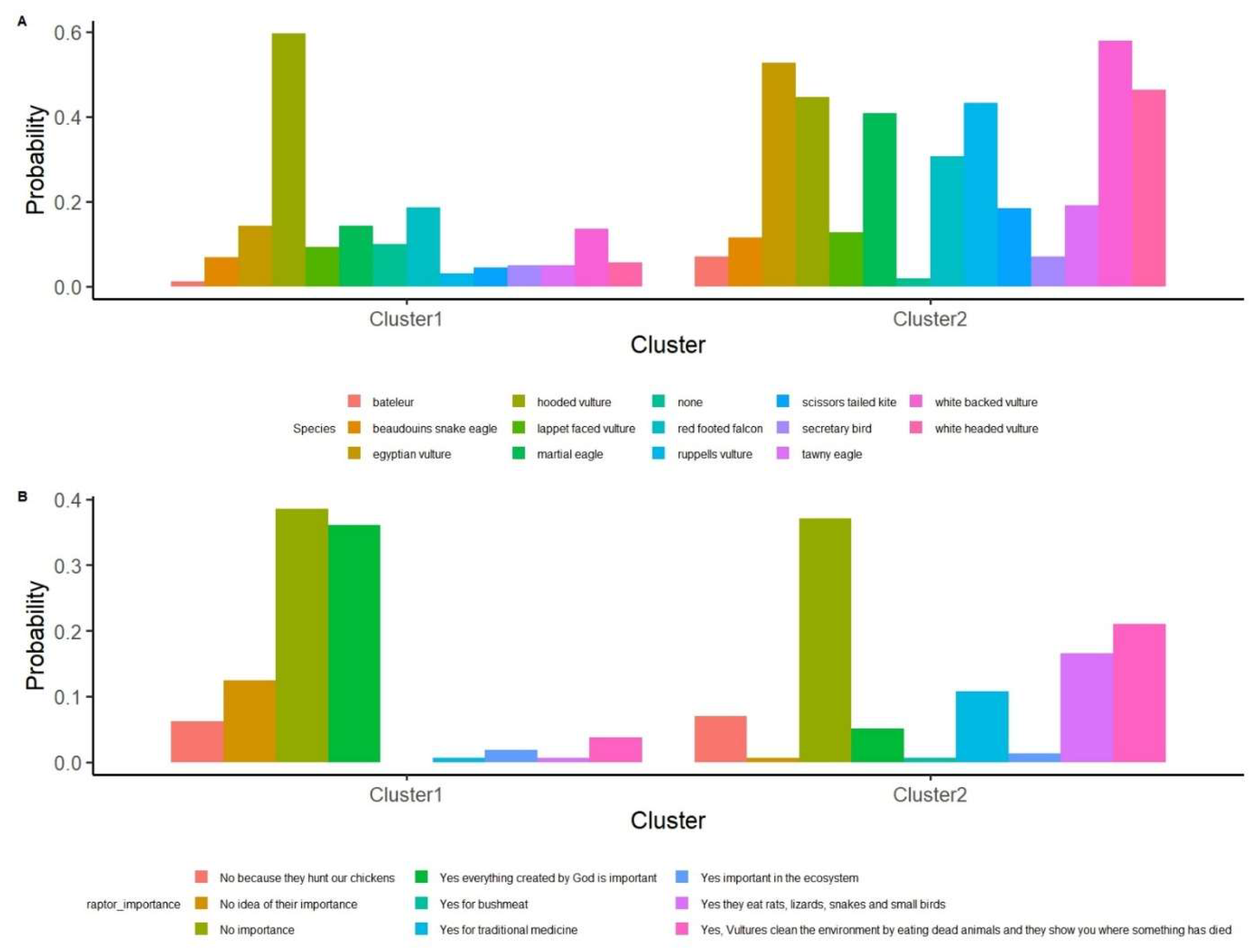

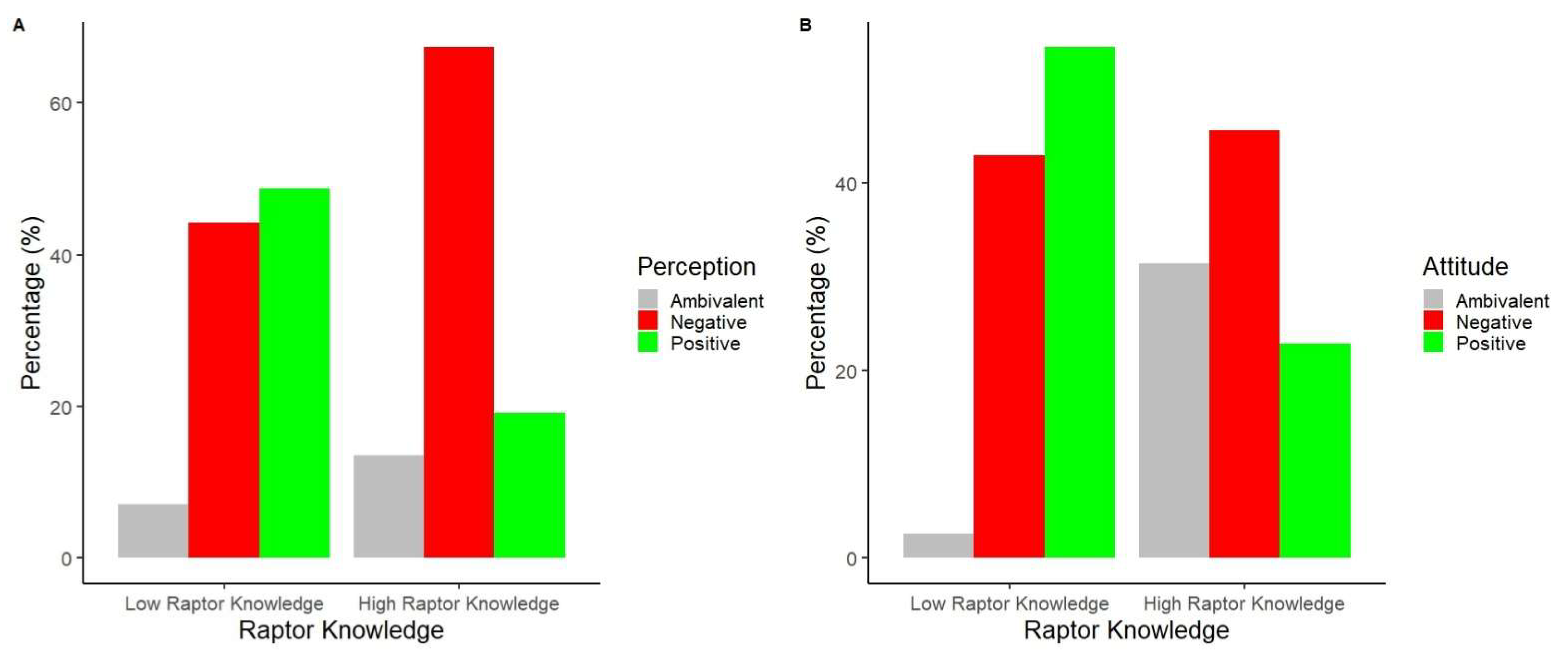
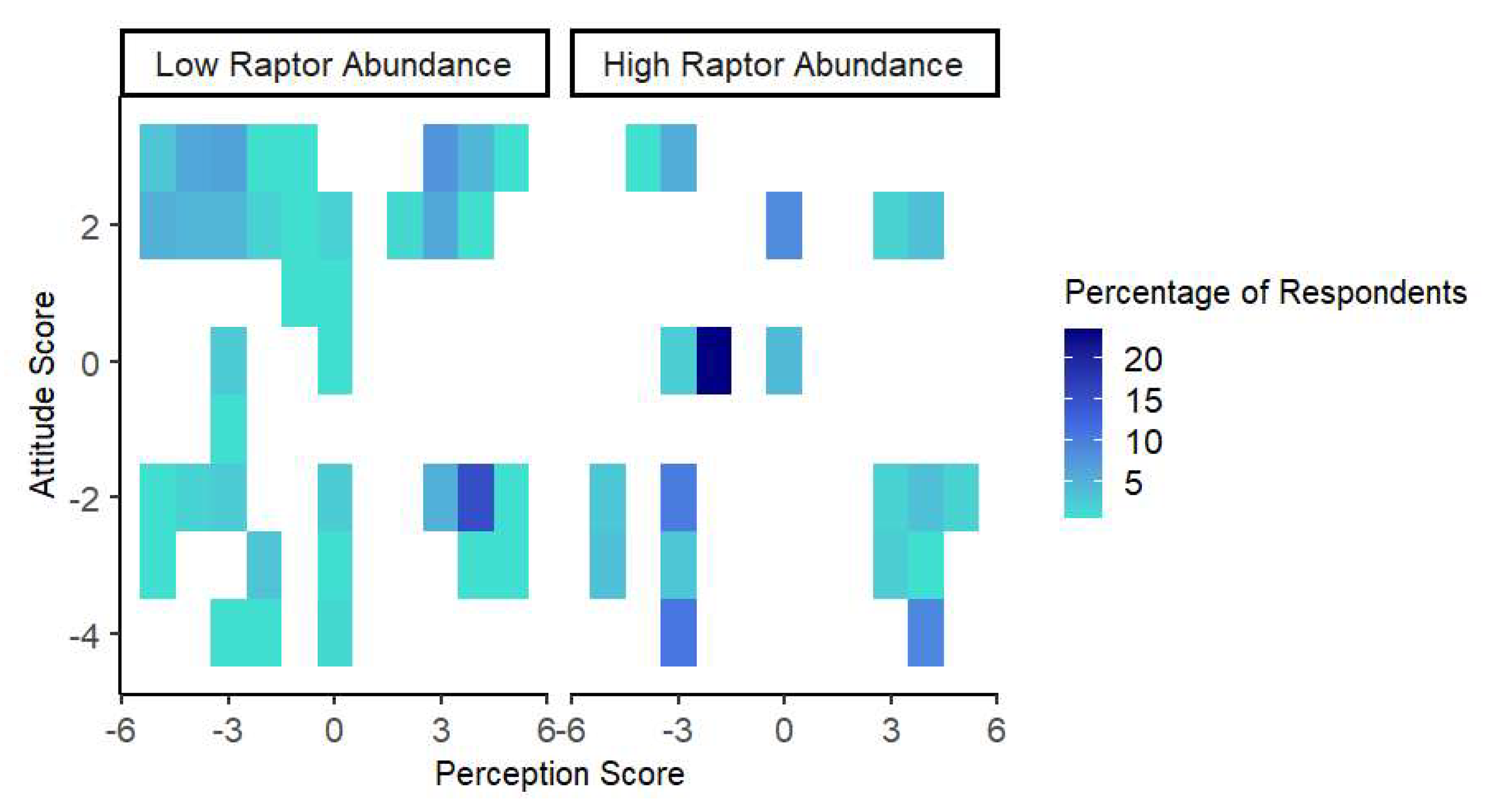
| Cluster | Log Likelihood | BIC | Free Parameter |
|---|---|---|---|
| 2-class | −4783.072 | 11,185.28 | 281 |
| 3-class | −4533.512 | 11,498.61 | 422 |
| 4-class | −4488.676 | 12,221.39 | 563 |
| 5-class | −4309.166 | 12,674.82 | 704 |
| 6-class | −4201.964 | 13,272.86 | 845 |
| Variable | Category | Count | Percentage |
|---|---|---|---|
| Gender | Female | 52 | 16 |
| Male | 266 | 84 | |
| Age | 14–17 | 8 | 3 |
| 18–29 | 103 | 32 | |
| 30–39 | 78 | 25 | |
| 40–49 | 49 | 15 | |
| 50–59 | 31 | 10 | |
| 60+ | 49 | 15 | |
| Education | Islamic school | 5 | 2 |
| College | 52 | 16 | |
| None | 49 | 15 | |
| Primary | 93 | 29 | |
| Secondary | 119 | 37 | |
| Monthly income | 0–15,000 | 58 | 23 |
| 15,001–30,000 | 74 | 18 | |
| 30,001–60,000 | 112 | 18 | |
| 60,001–100,000 | 56 | 35 | |
| >100,000 | 18 | 6 |
| Estimate | Std. Error | z Value | Pr(>|z|) | |
|---|---|---|---|---|
| Ambivalent|Negative | −1.0978 | 0.3473 | −3.1615 | <0.01 ** |
| Negative|Positive | 0.4756 | 0.3421 | 1.3904 | 0.1644 |
| High Raptor Knowledge | 1.2867 | 0.4898 | 2.6273 | <0.01 ** |
| Negative Perception | 0.9792 | 0.3736 | 2.6209 | <0.01 ** |
| Positive Perception | 0.6306 | 0.3681 | 1.7134 | 0.0866 |
| Pentad with High Raptor Abundance | −0.9751 | 0.2541 | −3.8381 | <0.001 *** |
| High Raptor Knowledge: Negative Perception | −2.1363 | 0.4682 | −4.5630 | <0.001 *** |
| High Raptor Knowledge: Positive Perception | −0.8932 | 0.4897 | −1.8240 | 0.0682 |
Disclaimer/Publisher’s Note: The statements, opinions and data contained in all publications are solely those of the individual author(s) and contributor(s) and not of MDPI and/or the editor(s). MDPI and/or the editor(s) disclaim responsibility for any injury to people or property resulting from any ideas, methods, instructions or products referred to in the content. |
© 2025 by the authors. Licensee MDPI, Basel, Switzerland. This article is an open access article distributed under the terms and conditions of the Creative Commons Attribution (CC BY) license (https://creativecommons.org/licenses/by/4.0/).
Share and Cite
Antonio, B.; Iniunam, I.A.; Tende, T.; Chaskda, A.A. Threatened Raptor Species Distribution in Nigeria: Influence of Socio-Cultural Factors and Human–Wildlife Conflicts. Diversity 2025, 17, 602. https://doi.org/10.3390/d17090602
Antonio B, Iniunam IA, Tende T, Chaskda AA. Threatened Raptor Species Distribution in Nigeria: Influence of Socio-Cultural Factors and Human–Wildlife Conflicts. Diversity. 2025; 17(9):602. https://doi.org/10.3390/d17090602
Chicago/Turabian StyleAntonio, Benhildah, Iniunam A. Iniunam, Talatu Tende, and Adams A. Chaskda. 2025. "Threatened Raptor Species Distribution in Nigeria: Influence of Socio-Cultural Factors and Human–Wildlife Conflicts" Diversity 17, no. 9: 602. https://doi.org/10.3390/d17090602
APA StyleAntonio, B., Iniunam, I. A., Tende, T., & Chaskda, A. A. (2025). Threatened Raptor Species Distribution in Nigeria: Influence of Socio-Cultural Factors and Human–Wildlife Conflicts. Diversity, 17(9), 602. https://doi.org/10.3390/d17090602








